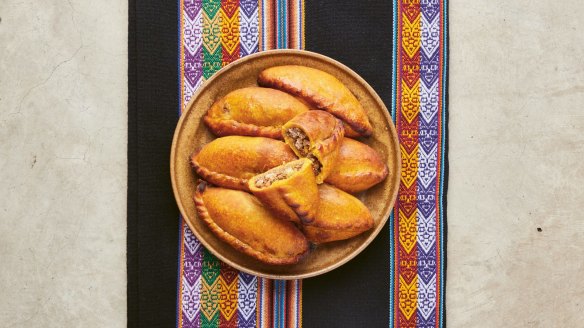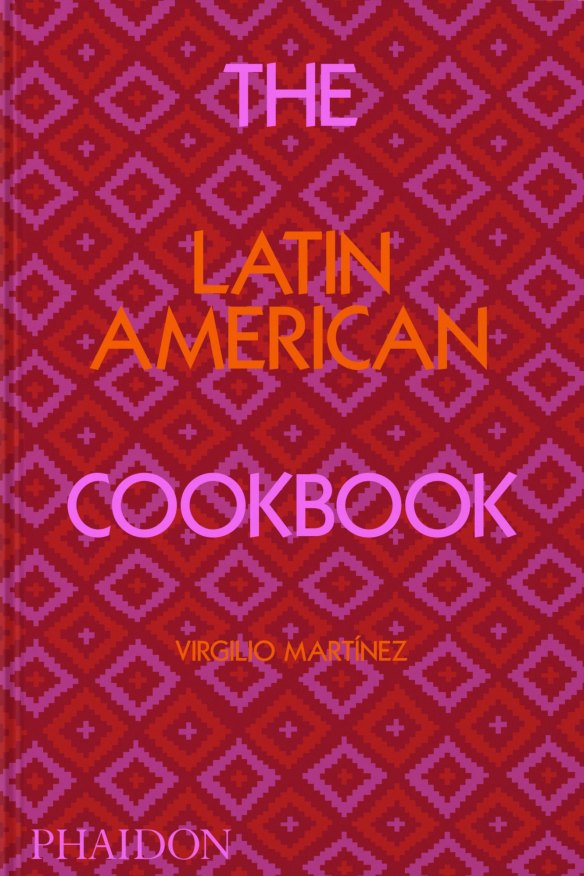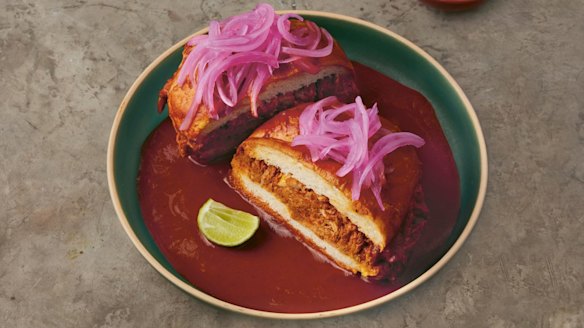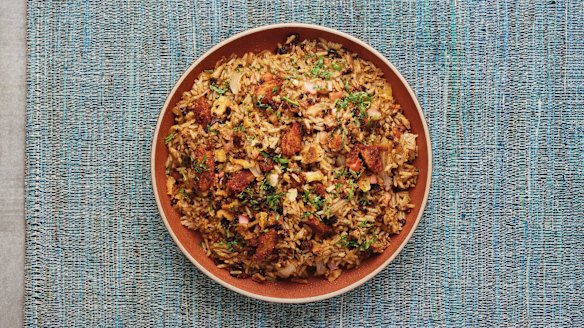Four delicious Latin American recipes anyone, anywhere can cook at home

With its vast array of ingredients and globally popular dishes, Latin America is best thought of as the "world's pantry", says Virgilio Martínez.
Potatoes, tomatoes, corn and cocoa are now staples in almost every country, while dishes such as tacos, tortillas, arepas and tamales have travelled far from their homelands.
"Wherever you are, you are eating Latin America on a daily basis, whether you realise it or not," the Peruvian chef and restaurateur writes in his new collection, The Latin American Cookbook.

The compilation is a snapshot of one of the world's most diverse geographical regions, featuring 600 recipes from 22 countries across Central and South America.
While Martínez's painstaking research strove to be faithful to the roots of each recipe, the cuisine itself is endlessly versatile and can be modified to local tastes and ingredients, no matter where you live in the world.
"Don't take every direction so seriously," he says. "Adapt each recipe to your own personal time and place. There's no right or wrong here.
"The very act of cooking helps keep the richness of Latin American food present, visible and relevant."
Bolivian-style turnovers (Saltena)
The flat-bottomed saltena, with its stewed interior, is like the soup dumpling of empanadas. Despite its name, which refers to the Argentine city of Salta, this baked empanada actually has its origins in Bolivia. During the dictatorship of Juan Manuel de Rosas in the 19th century, a writer named Juana Manuela Gorriti, from Salta, was exiled to Potosí just over the border in Bolivia and came up with the recipe as a way to make a living. People in Potosí would often say, "Go and pick up an empanada from 'la Saltena' (the woman from Salta)." The nickname stuck and eventually the dish left Potosí and spread around Bolivia, with many regions creating their own versions. To add to the confusion, the city of Salta is also known for its empanadas, which in Argentina are generally referred to as empanadas saltenas.
INGREDIENTS
For the dough
- 650g (5 cups) plain flour, plus extra for dusting
- 2 tbsp sugar
- 250ml (1 cup) melted butter
- 2 egg yolks
- 120ml (1½ cups) warm water with ½ tbsp salt added
- 1 whole egg, beaten, to glaze
For the filling
- 120ml (½ cup) melted lard
- 2 white onions, chopped
- 1 fresh aji amarillo, chopped (see note)
- 450g minced beef (or use shredded chicken)
- 1.2 litres (5 cups) beef stock
- 1 gelatin leaf, soaked in ice-cold water
- 3 tbsp parsley chopped
- 6 peeled and boiled potatoes, cut in small cubes
- 130g (1 cup) cooked peas
- 1 tbsp aji amarillo paste (see note)
- salt and ground pepper
METHOD
- Heat the lard for the filling in a large frying pan until very hot. Saute the onions and fresh chilli for 8 minutes or until soft and brown.
- Add the beef, cook for 4 minutes then pour in the stock with the squeezed-out gelatin and let it simmer for about 35 minutes.
- Add the parsley and season with salt and pepper, then remove from the heat.
- Add the potatoes and peas and place in the refrigerator until needed.
- For the dough, mix the flour and sugar in a bowl. Add the melted butter and mix with a wooden spoon.
- Add the egg yolks and slowly stir in the warm, salted water. Knead into a soft and uniform dough with your hands, then place on a floured surface and roll it out with a rolling pin to a thin sheet, about 3mm thick.
- Preheat the oven to 160C fan-forced (180C conventional. Using an 11cm round cutter, stamp out discs from the dough and place on a lined baking tray.
- Place a full tablespoon of the filling in the middle of each disc. Using your finger, wet the edges of the disc with water, and fold the empanada in half to seal. Repeat with remaining ingredients.
- Brush with beaten egg and bake for 15 minutes or until golden brown.
Makes 12
Note Aji amarillo is a fruity flavoured chilli that originates in Peru. If you can't find it, look for habanero chillies.

Drowned sandwich (Torta ahogada)
Hailing from Guadalajara in Mexico and found throughout the state of Jalisco, this sandwich, which soaks in a pool of extremely spicy chilli sauce, is said to have been created in the early 1900s by a street vendor who accidentally dropped the sandwich into a container full of salsa, which the customer loved. You can order it "media ahogada", which means the sandwich is only partially dipped in the sauce (a good option if you order from a street vendor and are eating with your hands), or "bien ahogada", meaning totally submerged in sauce. As an alternative to the very spicy chilli de arbol-based sauce, a sweeter, tomato-based version is sometimes offered. We use a mixture of both in the recipe below, though you can adjust as you see fit. The birote is a long, salted, crusty roll that helps hold the sandwich together amidst the sauce and carnitas. A good substitute is a hunk of baguette.
INGREDIENTS
- 675g pork shoulder
- 2 garlic cloves, chopped
- 1 bay leaf
- 250ml (1 cup) water
- 1 red onion, halved and thinly sliced into half-moons
- juice of 1 lime
- 4 birote rolls (or hunks of baguette)
- 4 tbsp coriander leaves, finely chopped
- salt and ground pepper
- lime wedges, to serve
For the spicy sauce
- (15g) dried chillies de arbol (see note)
- 250ml (1 cup) hot water
- 2 garlic cloves, chopped
- 2 tbsp apple cider vinegar
- 30g (¼ cup) toasted sesame seeds
- 1 tsp dried oregano
- 1 tsp ground cumin
For the tomato sauce
- 900g tomatoes
- ¼ tsp ground cumin
- ½ white onion, chopped
- 1 tsp dried oregano
- 1 garlic clove, chopped
- 1 tbsp olive oil
METHOD
- Preheat the oven to 160C fan-forced (180C conventional).
- Season the pork with salt, pepper and garlic, and place in a roasting pan. Add the bay leaf and water to the bottom of the pan and cook in the oven for 2 hours, turning the meat over after 1 hour; it is ready when a knife inserted in the middle comes out warm. Remove and let cool until warm, then shred the meat with your hands, and set aside.
- For the spicy sauce, place the chillies de arbol and hot water in a bowl and leave to soak for 15 minutes. Drain, and place the chillies in a blender with the garlic, vinegar, sesame seeds, oregano and cumin. Season with salt and pepper and blend until smooth. Strain the mixture and keep the liquid sauce.
- For the tomato sauce, boil the tomatoes in a pan of water for 10 minutes, then drain and peel. Clean the blender and add the tomatoes, cumin, onion, oregano and garlic, and blend to a paste. In a medium pan, heat the oil until hot, add the tomato mixture, and cook for 20 minutes, letting some of the liquid evaporate, stirring continuously so it doesn't stick.
- Season the red onion with lime juice and some salt and leave for 5 minutes.
- Cut open the bread and place some meat inside and then onions on the top. Pour some tomato sauce on the bread, add the spicy sauce and some coriander. Serve warm with lime wedges.
Serves 4
Note Chillies de arbol (arbol chillies) are available from Gerwurzhaus, Herbie's Spices and other online stores.

Chilean hot dog (Completo)
In the early 1920s, Eduardo Bahamondes Munoz, who had worked as a cook in the US for a few years, brought with him the concept of the hot dog. From a small cafe off Santiago's Plaza de Armas, he began serving hot dogs, but loading them up with toppings such as the smear of mashed avocado that has become emblematic to the completo. The favourite for many is the Italiano, which will give you the green, white, and red of the Italian flag via avocados, mayonnaise and chopped tomatoes. There's also A lo Pobre, with fried onions, French fries, and a fried egg. You can put anything you want on a completo, really, and many vendors offer a variety of additional toppings like salsa Americana (a slaw of pickled onions, carrots, and cucumbers), crunchy shoestring potato fries, and grilled onions.
INGREDIENTS
- 1 tbsp olive oil, plus extra to season
- 4 hot dogs (frankfurters)
- ½ onion, finely chopped
- 4 hot dog buns
- 2 tomatoes, finely diced
- 2 avocados
- juice of 1 lime
- 4 drizzles of mayonnaise
- salt
METHOD
- Heat the oil in a medium pan. Add the hot dogs (frankfurters) and cook, turning occasionally, for about 5 minutes or until cooked.
- Put the onion in a bowl of iced water for 5 minutes, then drain and reserve.
- Toast the buns until slightly brown.
- Season the tomato with olive oil and salt.
- Peel and pit the avocados, scoop the flesh into a bowl, season with lime juice and salt, then mash them using a fork.
- Add a hot dog to each bun while still hot, then add some tomato and onions, mashed avocado, and lastly a generous drizzle of mayonnaise.
Serves 4

Campfire rice (Arroz de carreteiro)
This dish originated from the drivers of horse-pulled wagons in southern Brazil. On long voyages across the countryside, cooked rice with dried meat was an easy meal to prepare in a cast-iron pot over a fire. Today it's commonly made with leftovers from a barbecue, and is one of the most typical dishes of Rio Grande do Sul. Similar dishes can be found elsewhere in the country, like arroz Maria Isabel in the northeast, using lightly salted and dehydrated carne de sol instead of the drier charque, or feijao tropeiro, from Minas Gerais, adding beans and leafy greens.
INGREDIENTS
- 360g (2 cups) long-grain white rice
- 2 tbsp oil
- 80g bacon, diced
- 250g spicy Calabrian-style cured sausage, cut into 3 sections
- ½ onion, thinly sliced
- 2 garlic cloves, finely chopped
- 100g beef jerky, shredded
- 2 bay leaves
- 1 tomato, peeled and chopped
- 1 litre (4 cups) hot beef stock, or water
- 20g (½ cup) parsley, chopped
- salt and ground pepper
METHOD
- Rinse the rice in cold, running water until the water runs clear.
- Heat the oil in a large pan over medium heat. Add the bacon and sausage and cook for 5 minutes, stirring occasionally, until brown. Add the onion and garlic and saute for 2 minutes. Add thejerky and let brown. Add the rice and bay leaves, then the tomato, and saute for a minute or so. Add salt to taste.
- Add the hot stock or water and scrape the bottom of the pan with a wooden spoon so the rice doesn't stick. Cover with a lid and cook for about 20 minutes or until the rice has absorbed the water.
- Remove from the heat and rest, with the lid on, for about 10 minutes.
- Serve scattered with parsley and some pepper.
Serves 6
This is an edited extract from The Latin American Cookbook by Virgilio Martínez, published by Phaidon, RRP $65. Buy now
Appears in these collections
The best recipes from Australia's leading chefs straight to your inbox.
Sign up